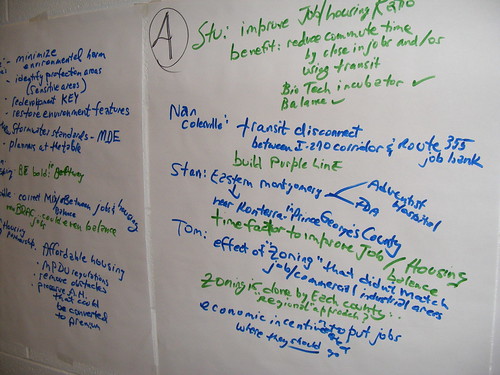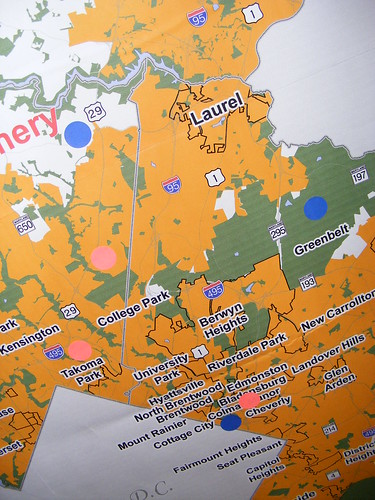 Stuart Rochester discusses development in East County as moderator Jim Cohen watches during last Thursday's Smart Growth "listening session" at Blake.
Stuart Rochester discusses development in East County as moderator Jim Cohen watches during last Thursday's Smart Growth "listening session" at Blake.Anticipating a million new residents statewide by 2030, Maryland planners sat down with fifty Montgomery and Prince George's residents to discuss how the state should grow at a "listening session" last Thursday at Blake High School in Cloverly.
Dubbed an "open mike" by Secretary of Planning Richard Hall, each of the six listening sessions being held across the state gives people the chance to speak with Department of Planning officials directly. At issue was Maryland's eleven-year-old Smart Growth program, which sought to curb sprawl by directing development to designated "priority funding areas" in established communities. Located in the far northern fringes of Silver Spring and surrounded by sprawling new homes on two-acre lots, Blake was an ironic choice for a location to talk about Smart Growth, as Greater Greater Washington pointed out two weeks ago.
Several speakers cited past planning mistakes as challenges for the future. Stuart Rochester, local activist and Fairland resident, questioned the "growing infatuation with Smart Growth," noting the construction of apartments in the Route 29 corridor in anticipation of a light-rail line that was never built. "We have to be very careful when we presume Smart Growth around transportation when it may just be wishful thinking," he said.
so much more AFTER THE JUMP . . .
"We had zoning laws that said it was better to work here and live here and shop somewhere else," said another speaker, who also noted that businesses have chosen to locate along I-270 rather than in East County because of tax incentives offered there. "There's a place in Burtonsville [Office Park] that has pressure to be anything but jobs, but it needs to be jobs. It's right on 29. We need the economic incentive."
Rochester also stressed the need for more employment opportunities on the east side. "You get more higher-paying jobs, you improve the socioeconomic make-up, the demographic make-up [of East County]," he said. "This is what we need to encourage, more than housing density."
 Comments from local residents were written on large boards. BELOW: Meeting attendees placed orange dots on locations that should be developed and blue dots on those that should be preserved.
Comments from local residents were written on large boards. BELOW: Meeting attendees placed orange dots on locations that should be developed and blue dots on those that should be preserved.Harry Sanders, co-founder of the Action Committee for Transit and board member of Purple Line Now! was the first to bring up the state's recent cuts to local transit projects, including the Purple Line. He mentioned that he first moved to Woodside thirty years ago in anticipation of Metro coming to Silver Spring. "If you calculate the value of public transit in providing a range of good things, it's worth it, but it needs to come together with good planning," said Sanders.
 Stan Doore of Calverton suggested monorails as one solution to the state's transportation woes. President of the Maryland-Virginia Monorail Initiative, Doore campaigned for a referendum on building a regional monorail system six years ago. "Transit costs four times more per mile than a personal car," said Doore, whose comments were cut short twice by the event's moderator. "If you elevate it, you're above the congestion and you can have driverless vehicles."
Stan Doore of Calverton suggested monorails as one solution to the state's transportation woes. President of the Maryland-Virginia Monorail Initiative, Doore campaigned for a referendum on building a regional monorail system six years ago. "Transit costs four times more per mile than a personal car," said Doore, whose comments were cut short twice by the event's moderator. "If you elevate it, you're above the congestion and you can have driverless vehicles."One person questioned the need for any growth at all, suggesting that the problem lay not with the state but with vaguely defined outside forces. "Do we just have to accept that we'll have one million more people in 20 years?" asked Dan Smith of Cheverly. "Maybe the State should be thinking about some international policies that would allow us to not concentrate people in this region."
"What are you talking about?" asked a member of the audience. "Birth control? Closing our borders?"
The Department of Planning will compile comments from each of the six listening sessions, along with results from an electronic survey given to attendees, into a report that they'll submit to the state legislature in December. While creating a plan to accommodate a million new residents seems daunting, Sheldon Fishman of Forest Glen reminded the audience that Maryland's tackled big projects in the past, like the building of the Capital Beltway. He had just five words for the planners: "My suggestion is, 'Be bold.'"

1 comment:
Maybe we really do need to take a strong stand against outside forces that press unlimited growth on us at unsupportable rates.
At one point in time, Maryland was one of the most "woman's freedom of choice" states in the Union and Montgomery definitely led that charge. Indeed, there used to be vocal protesters against the Federal policy of unilaterally banning any form of contraception in foreign aid packages.
As a result, we see places in "Latin America" which have outlawed abortion and made it nearly impossible to get any other kind of birth control, and those places are now full to bursting and so mired in consequent poverty that they must export significant proportions of their population.
We as a nation cannot admit people at a rate sufficient to begin to offset the reproductive capacity of the rest of the world. We can, however, try to limit our population growth to a reasonable level. And outside of immigration, we did that successfully starting in the 1970s.
Just because the Federal government shirked its responsibility to secure the borders, there's no reason that we as Marylanders should honestly and straightforwardly accept that we will have to Pave the Bay real soon now, or maybe just call ourselves bees and start living in hives.
Post a Comment